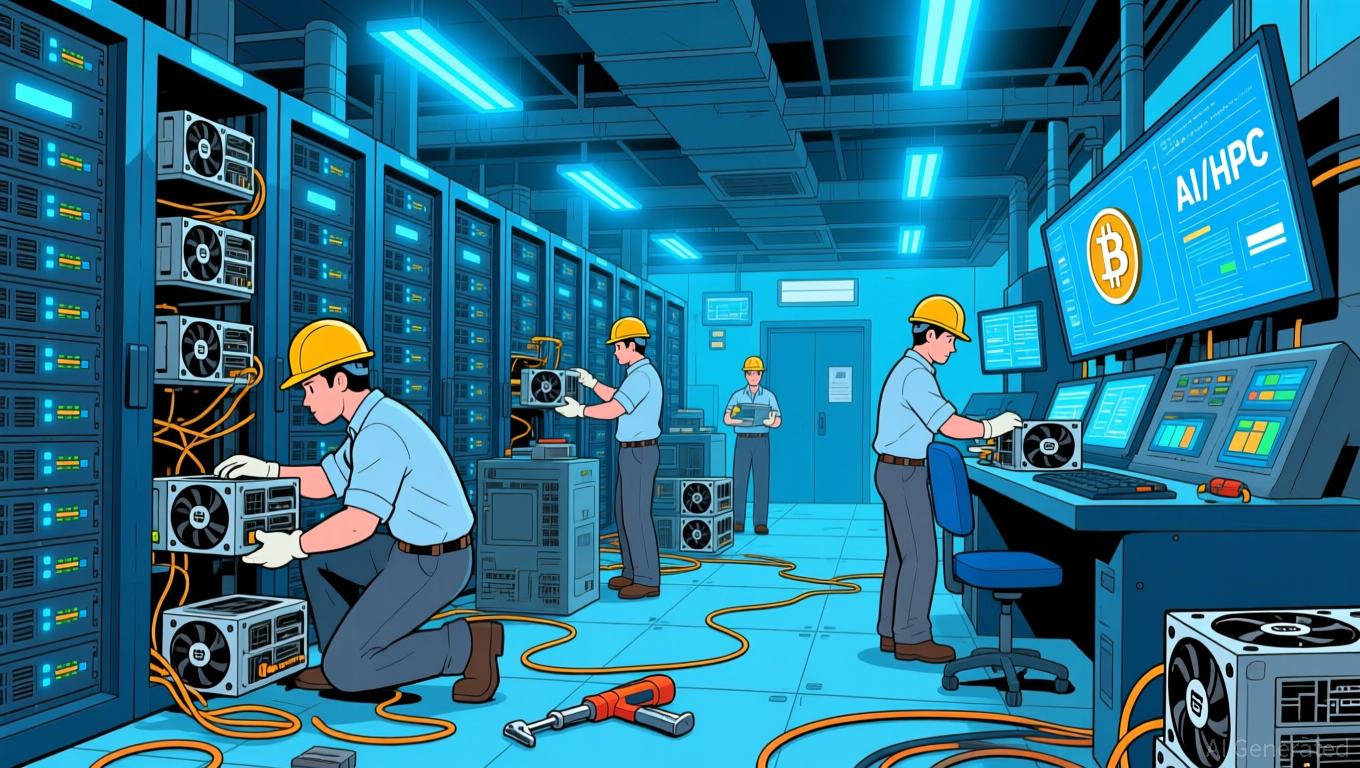Bitcoin News Update: As AI Sparks a Modern Gold Rush, Bitcoin Miners Shift Focus from Blocks to Bytes
- Bitcoin miners like CleanSpark pivot to AI/HPC as mining profitability declines, raising $1.15B for infrastructure expansion and share buybacks. - Industry peers TeraWulf and Core Scientific expand HPC capacity, shifting valuation focus to AI hosting revenue ($1.5-2M/MW/year) over hashrate growth. - Regulatory hurdles and GPU shortages challenge AI infrastructure scaling, but long-term demand projects U.S. data-center electricity use to hit 606 TWh by 2030. - Hybrid crypto-AI infrastructure becomes a sca
With profits from traditional Bitcoin mining shrinking, miners are rapidly branching out into artificial intelligence (AI) and high-performance computing (HPC).
This development follows Bitcoin mining difficulty reaching an all-time high of 155.97 trillion in late October 2025, marking a 6.31% increase from the previous adjustment. Meanwhile, hashprice revenue—the earnings per unit of computational power—fell to $41 per terahash per second (TH/s), approaching levels that threaten the survival of smaller miners,
CleanSpark’s $1.15 billion offering, increased from an initial $1 billion, carries 0.00% interest and a 27.5% conversion premium over its $15.03 share price at the time of announcement. Of the funds, $460 million will be used to buy back shares at $15.03 each, while the rest will go toward acquiring power and land, building data centers, and paying off bitcoin-backed credit lines,

This approach is similar to that of other companies like TeraWulf Inc. (WULF), which saw an 87% increase in revenue year-over-year in Q3 2024, fueled by both Bitcoin mining and AI/HPC services. TeraWulf’s Lake Mariner facility in New York now provides 22.5 MW of HPC capacity under long-term agreements with Fluidstack, supported by a $1.8 billion credit enhancement from Google,
The move toward AI is changing how mining companies are valued. Investors are now focusing more on contracted AI hosting revenue—ranging from $1.5 to $2.0 million per megawatt annually—rather than just hashrate growth,
Yet, obstacles remain. Regulatory issues, such as New York’s emissions reduction requirements for Greenidge Generation Holdings, underscore the importance of environmental compliance in AI infrastructure projects,
Experts point out that while Bitcoin’s price swings remain unpredictable, the transition to AI hosting provides miners with a cushion against the sector’s volatility. Marathon Digital Holdings (MARA), which acquired a 64% stake in EDF’s Exaion unit, and Iris Energy (IREN), which runs GPU clusters powered by renewables, are examples of the industry’s move toward more diverse revenue streams,
After CleanSpark announced its bond offering, its shares fell 4.9% in premarket trading, reflecting investor concerns about potential dilution from the convertible notes,
As Bitcoin miners contend with a bearish market, their shift toward AI marks a major transformation: facilities capable of supporting both ASIC and GPU workloads are becoming more valuable than raw hashrate alone. For CleanSpark and its competitors, securing access to power, land, and the electrical grid will be crucial for success as digital infrastructure becomes the backbone of both cryptocurrency and AI growth.
Disclaimer: The content of this article solely reflects the author's opinion and does not represent the platform in any capacity. This article is not intended to serve as a reference for making investment decisions.
You may also like
Noomez's Scarcity Engine: Creating Value for Crypto's 2025 Bull Market
- Noomez ($NNZ) gains traction with a 28-stage presale using escalating prices, permanent token burns, and liquidity locks to create scarcity and 1000x return potential. - The deflationary model includes 280B fixed supply, 50% allocated to presale, with Vault Events at stages 14/28 triggering additional burns and airdrops. - Transparency features like the Noom Gauge dashboard and 15% liquidity locks, plus 66% APY staking rewards, differentiate it from speculative meme coins. - Stage 3 shows 51% price growt

Public Company's $IP Token Reserve Marks the Beginning of a Programmable IP Economy Era
- Crypto.com partners with IP Strategy, first public company to use $IP tokens as primary reserve asset. - Agreement includes custody, trading, and staking for 52.5M $IP tokens valued at $230M, boosting institutional IP token adoption. - Partnership enables regulated exposure to $80T programmable IP economy via Story Protocol's blockchain infrastructure. - Executives highlight infrastructure's role in securing IP assets while risks like liquidity and custody execution remain critical concerns.

Meta’s lead AI researcher Yann LeCun is said to be preparing to depart in order to launch his own company